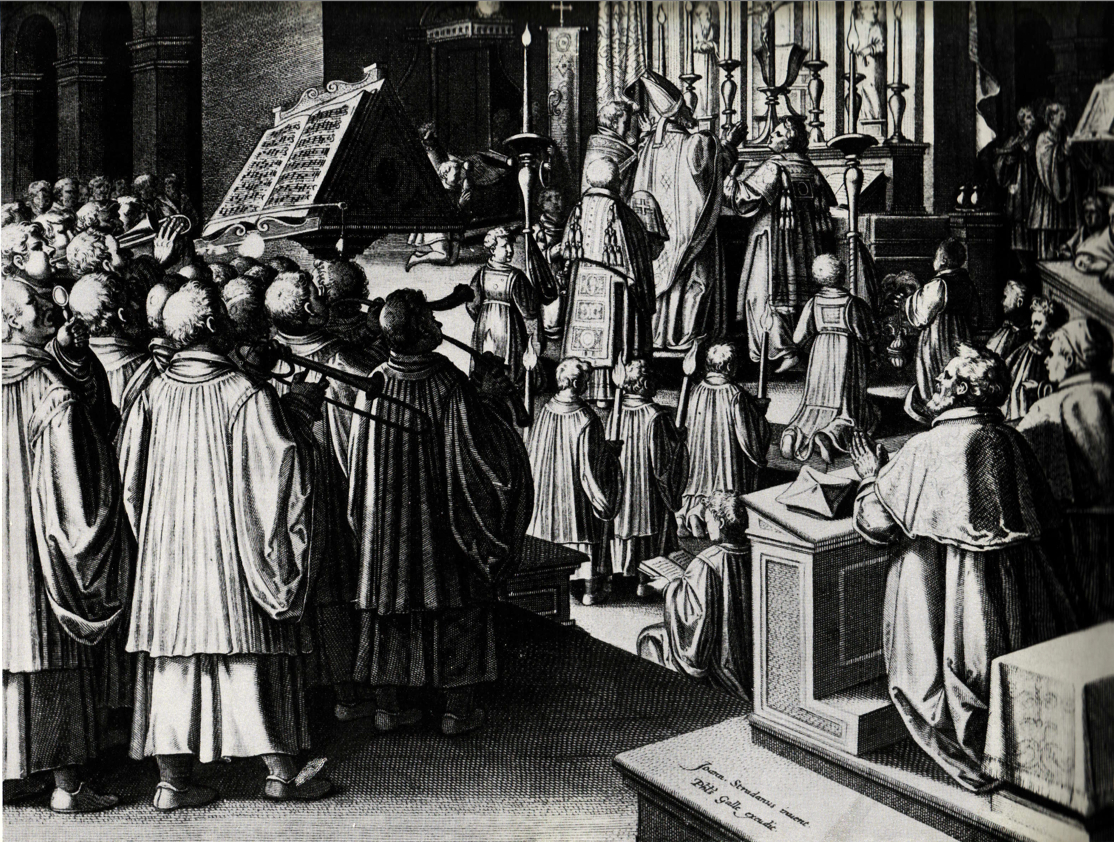Scholars sometimes speculate about when a given instrument began reading music. This date has implications on what types of ensembles the instrument participated in, its musical skill level, and its musical status, among other things. During the time period in which the trombone probably began reading music, most published music did not indicate specific instrumentation. Turning to visual records, it must be acknowledged that, for various reasons, historical visual depictions are often not literal. However, visual depictions—particularly groupings and patterns found across multiple depictions—can at least give us a feel for general trends. My opinion, based on the visual record shown below, is that the trombone was playing from written music throughout most of the 16th century, probably beginning sometime in the early part of the century.
1526—In the famous series of woodcuts entitled The Triumph of Maximilian, executed primarily by artist Hans Burgkmair, one image (Plates 25 and 26) depicts a wagon transporting the Emperor’s Hofkapelle (court music ensemble), with cornett, trombone, and a number of singers. All the musicians are reading from a large music desk. Maximilian’s instructions for the engraving are the following: “Again depict a similar small low car with plough wheels, drawn by two bison; a boy shall drive them and bear the Kapellmeister’s verse. On the car should be the choir, and also cornett players and trombonists arranged in good order. Herr Jorg Slatkany (Bishop of Vienna) shall be Kapellmeister and his verse shall be as follows: How by the Emperor’s instructions he arranged the choral singing most delightfully….Stewdl shall be leader of the trombonists, Augustin of the cornett players, and their verse, borne by a boy on the car, shall read thus: How by the Emperor’s instructions they attuned the trombones and cornets in most joyous manner. (The cornets and trombones we placed So that the choral song they graced, For His Imperial Majesty Has often in such harmony Taken great pleasure, and rightly so, As we have had good cause to know).” See below image (Burgkmair, Triumph 5-6, plate 26; public domain). Click to enlarge.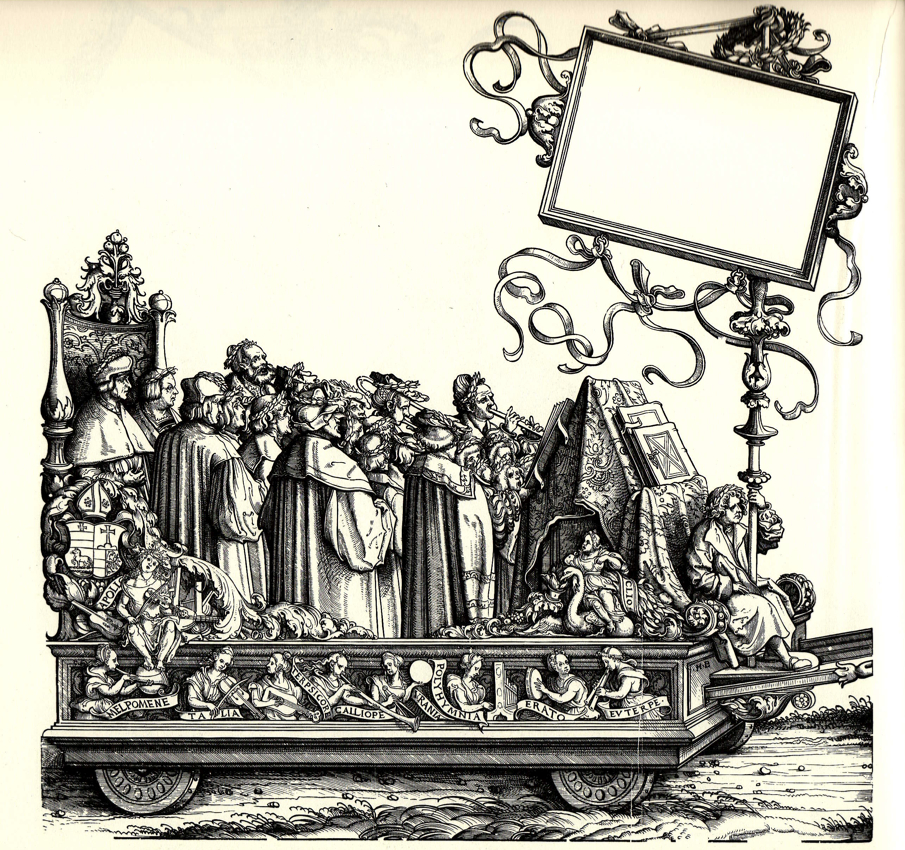
c. 1530—Augsburg, Germany: Hans Burgkmair (or his circle) paints a pair of images, Concert of Sacred Music and Concert of Secular Music, on wood panels. Concert of Sacred Music includes trombone and cornetto players performing with a group of singers in front of a large music stand (see below image; public domain).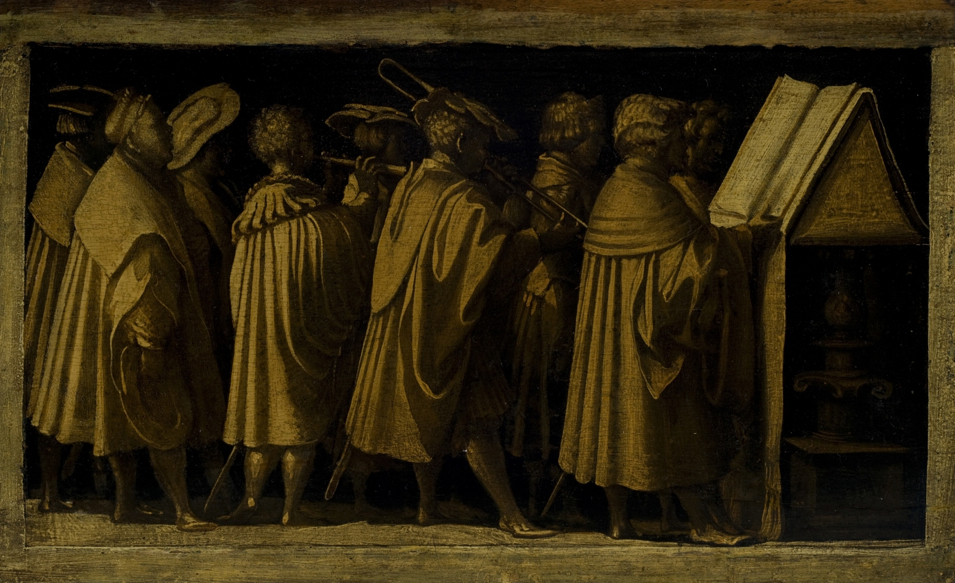
1540—Southwest Germany: An anonymous oil painting entitled Der Castalische Brunn, originally the property of Basel physician Felix Platter (1536-1674), depicts a trombonist playing with an outdoor ensemble. As in numerous other art works, vocalists and instrumentalists appear to share music. One of several music books is laid out on the table near the trombonist (see below detail; public domain) (Historisches Museum Basel, Inv. No. 1906.2901).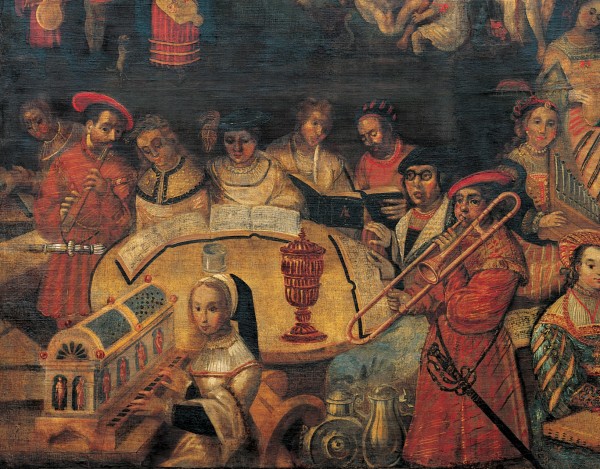
c. 1545—Italy: Giorgio Vasari, the famous Florentine artist and historian, paints a fresco of a quintet of wind musicians. The ensemble, comprising four cornetts and a trombone, plays from a window or balcony. The player’s grip of the trombone is somewhat unorthodox and the player is also holding the instrument left-handed. The bell is partially obscured by the player’s head. Three different sets of music rest on the edge of the opening (see below image, click to enlarge; public domain) (source: wikimedia commons; Stewart Gardner Museum).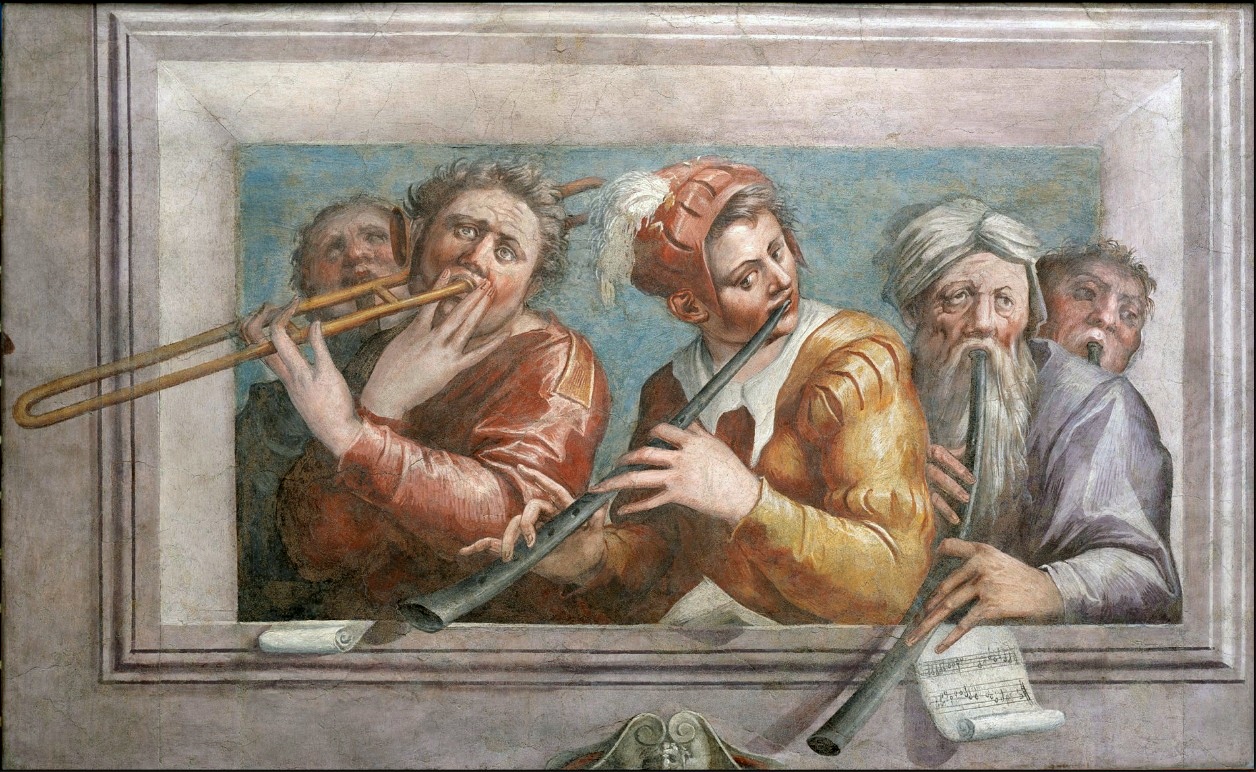
1549—Munich, Germany: Outdoor Feast, a painting by Hans Mielich (Müelich), court painter for Duke Albrecht V, depicts an outdoor wedding banquet. The music ensemble in the foreground includes two trombone players, one of whom appears to have multiple instruments in his hands and is apparently in the act of switching from one trombone to another. The painting also shows, in a different area (middle-left), a dance band consisting of what may be two trombones and a shawm. In the ensemble in the foreground, the instrumentalists look at music being held by two different individuals standing within the group (see below detail; click to expand; public domain image) (Kenton plate 14; Buchner plate 95).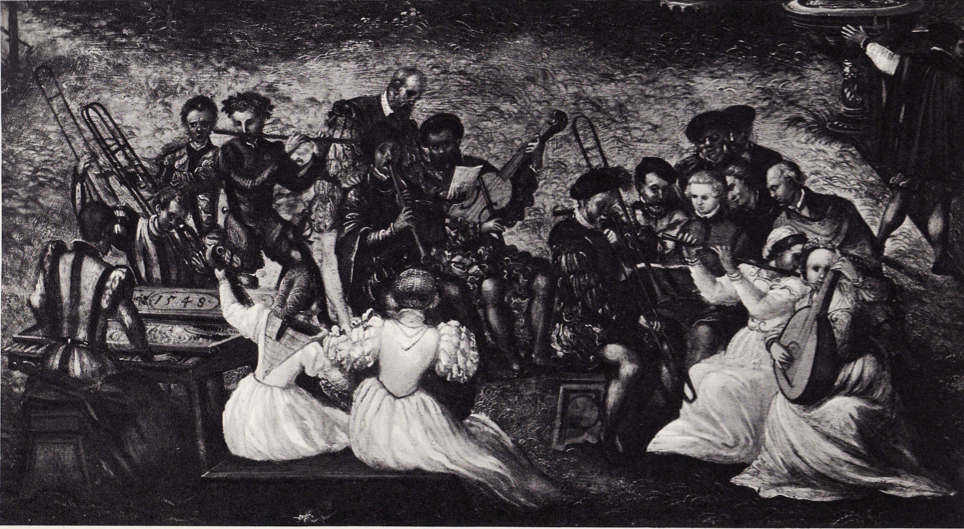
c. 1550—Netherlands: Artist Martin van Heemskerck includes a trombone-playing muse in his panel painting, Apollo and the Muses (see detail and full image below; public domain; wikimedia commons) (New Orleans Museum of Art). This instrument appears to be relatively small and is perhaps an alto trombone. Musicians gather around the organ, upon which rests a sheet of music. Although it is difficult to say for certain because of the crowded configuration of the musicians, the hand pointing at the music appears to belong to the trombonist (notice the hem on the sleeve, which matches the hem of her collar). Colin Slim proposes the date 1546 in his article, “On Parnassus with Maarten van Heemskerck,” part II (Musica Disciplina, 1997).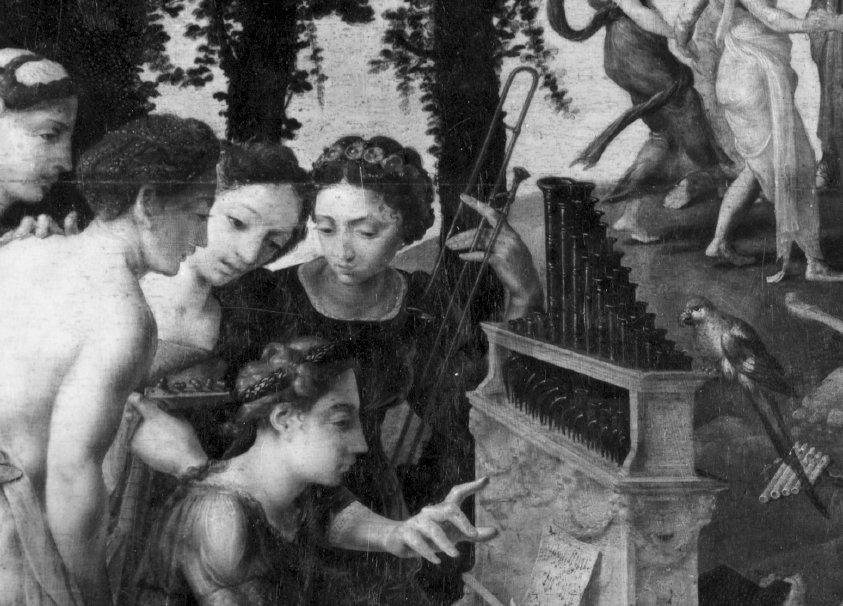
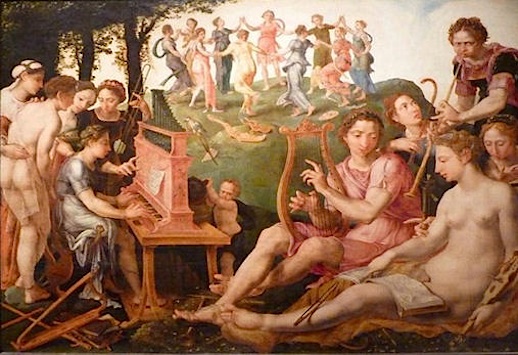
c. 1550—Tlaxcala, Mexico: An anonymous painting in the church of San Esteban in Tizatlan, Tlaxcala, depicts an alta capella of angel musicians consisting of three shawms and a trombone. The group plays from a large music stand (see below image; public domain) (Starner 110). A wider view of the image can be seen here or here (see upper-right).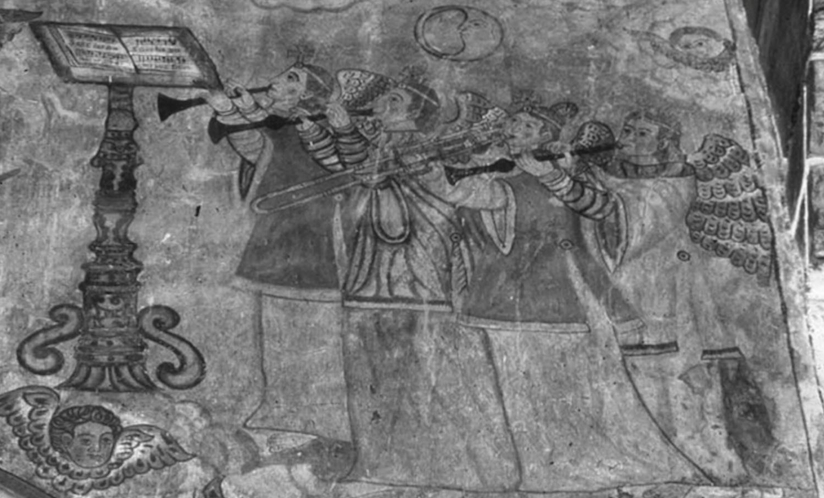
1551—France: After this date, an anonymous Nativity long attributed to engraver Jean de Gourmont is painted. The painting includes several cherub musicians, with one playing the trombone. A long banner that appears to have music printed on it is stretched before several of the musicians, including the trombonist (see detail and full image below; click to expand; public domain) (The Louvre).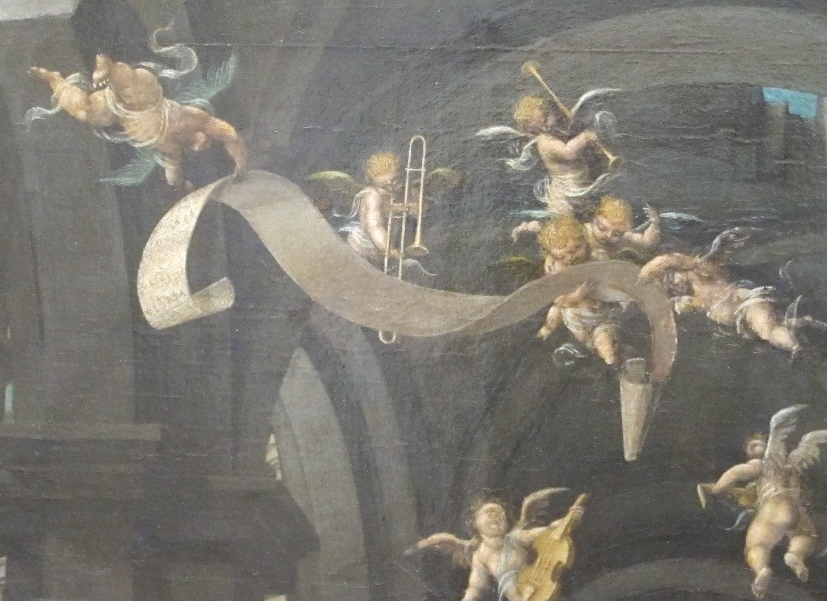
1564—Sevilla, Spain: At the Seville Cathedral, a bronze medallion by Juan Marín and Bautista Vázquez portrays two trombones performing with a cornett and two shawms. The five players are all gathered around a single music stand (see below image; public domain) (Kreitner, Minstrels in Spanish Churches).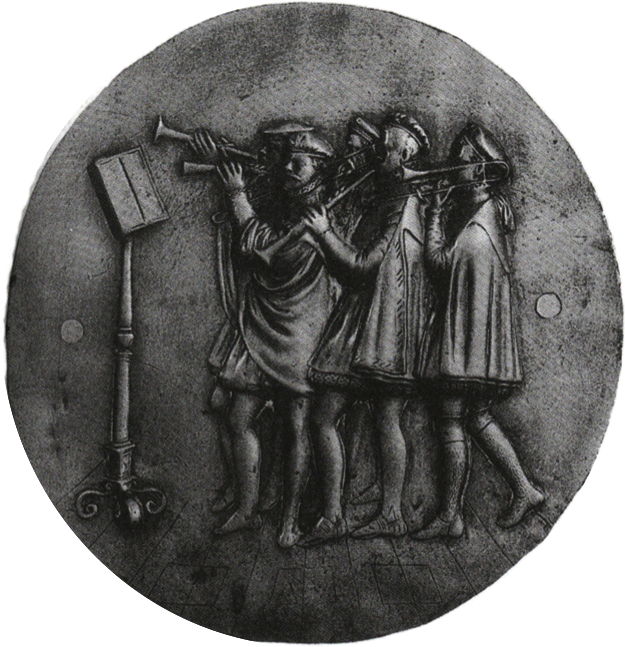
1577—Pallanza, Italy: Aurelio Luini and Carl Urbino complete a fresco in the church, Madonna di Campagna, that includes an angel-trombonist. It is not completely clear, but the trombone player may be reading music held by the cherub directly in front of him (see below detail, click to expand; public domain).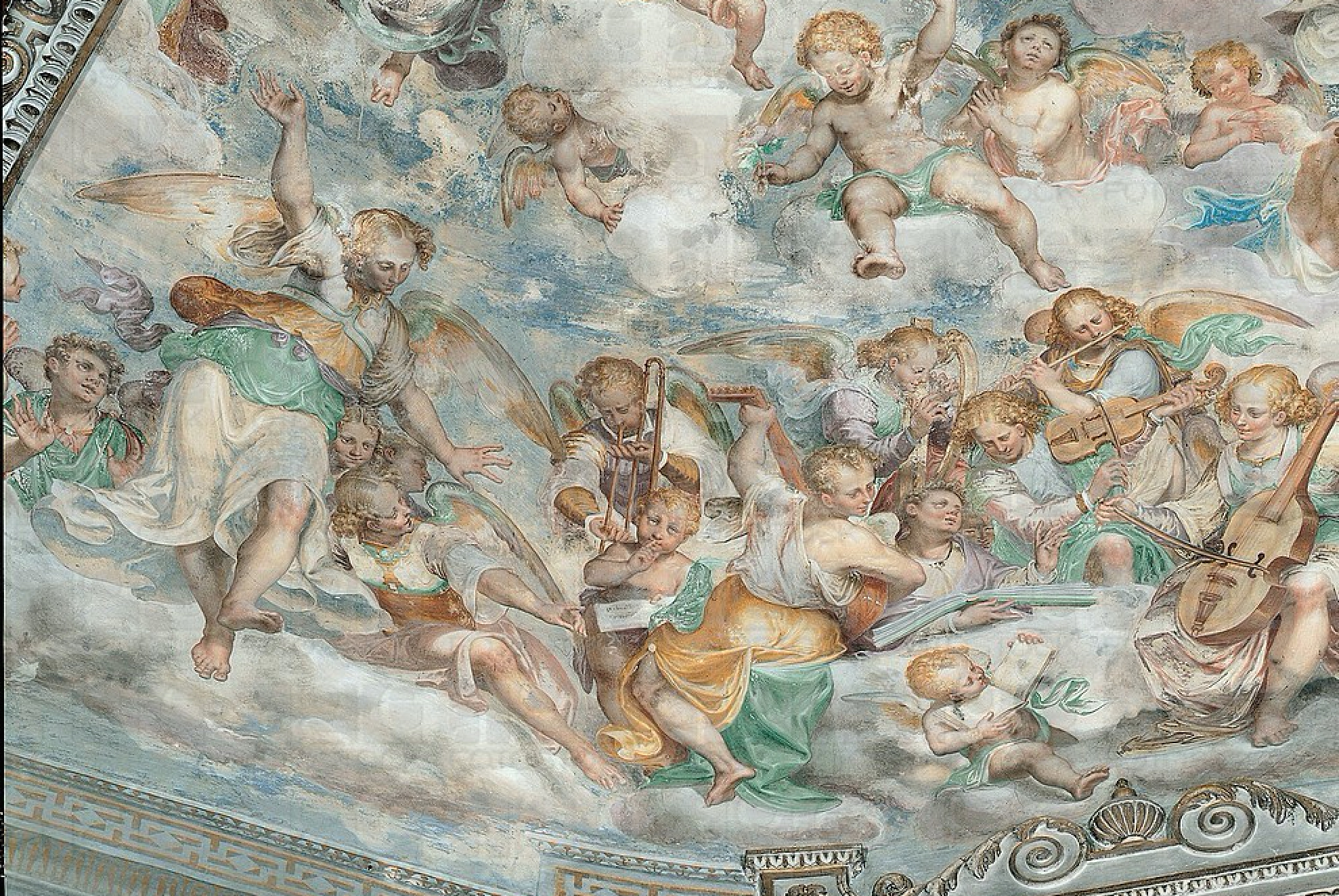
1578—Antwerp, Belgium: A set of masses by George de la Hele includes an image—an initial D in front of a group of cherub musicians—that features a rear-facing trombone being played by a cherub (also rear-facing). They all read from a large music book (see below image; public domain; Wangermée vol. 1 167).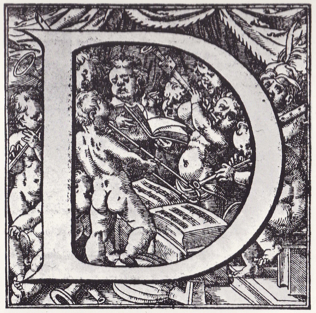
c. 1585—Munich, Germany: Pieter de Witte, court painter in Munich, paints David Singing God’s Praise, which features a trombone among a mixed consort of angel-musicians. The upper half of the painting, shown below, is meant to depict Saint Cecilia and angels. Among the angels, on both sides of the image, are angels holding music for the musicians (Haarlem, Frans Hals Museum; Pieter Fischer 22; Bergquist xvii) (public domain image). Click to expand.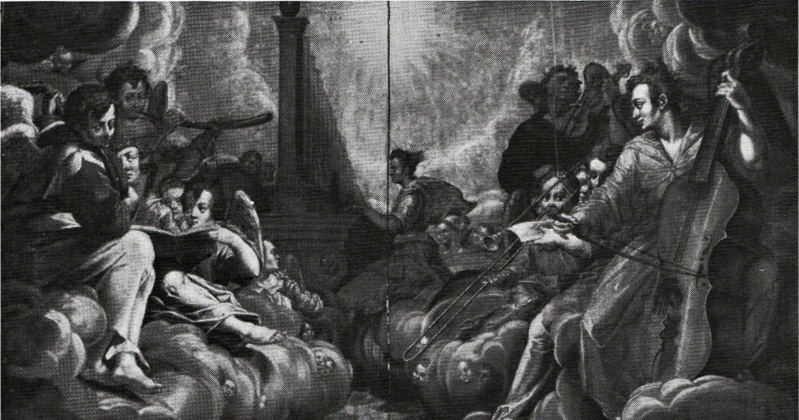
1595—Antwerp, Belgium: Philippe Galle’s copperplate engraving, after a work by Johannes Stradanus (Jan van der Straat), features trombone performing in a sacred setting, during the celebration of a Mass. One trombone is pictured in the immediate foreground, while another, possibly an alto trombone, is shown very near the music desk. What is possibly yet another trombone is pictured in the shadows in the upper right of the image with another music desk and a cornetto (click on image to expand). The text at the bottom of the engraving reads, “The people refine the heavenly worship with melodious arts and adorn the sacred rites with song. The horns fill the holiest portion of the temple with many sweet tones; the fistula [reed pipe] plays harmoniously with the Etruscan trumpet, and discord delights the souls, and the Muse lifts the earthly minds to the heavens” (see below image; click picture for larger version; public domain) (Salmen, Musikleben im 16 183; Naylor 10).